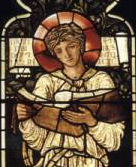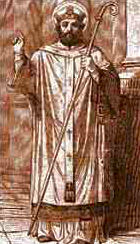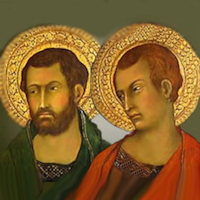Ordinary Time: January 26th
Memorial of Sts. Timothy and Titus, bishops
St. Timothy, born in Galatia in Asia Minor, was baptized and later ordained to the priesthood by St. Paul. The young Galatian became Paul's missionary companion and his most beloved spiritual son. St. Paul showed his trust in this disciple by consecrating him bishop of the great city of Ephesus. St. Timothy was stoned to death thirty years after St. Paul's martyrdom for having denounced the worship of the goddess Diana. In the 1962 Missal, St. Timothy's feast is celebrated on January 24 and the feast of St. Titus is on February 6.
St. Titus, a convert from paganism, was a fellow laborer of St. Paul on many apostolic missions. St. Paul later made him bishop of Crete, a difficult charge because of the character of the inhabitants and the spread of erroneous doctrines on that island. St. Paul's writings tell us that St. Titus rejoiced to discover what was good in others and drew the hearts of men by his wide and affectionate sympathy.
St. Timothy Timothy was Paul's dearest disciple, his most steadfast associate. He was converted during the apostle's first missionary journey. When Paul revisited Lystra, Timothy, though still very young (about twenty) joined him as a co-worker and companion. Thereafter, there existed between them a most intimate bond, as between father and son. St. Paul calls him his beloved child, devoted to him "like a son to his father" (Phil. 2:22). Of a kindly disposition, unselfish, prudent, zealous, he was a great consolation to Paul, particularly in the sufferings of his later years. He also assisted the apostle in the establishment of all the major Christian communities and was entrusted with missions of highest importance. Timothy was with Paul during his first Roman imprisonment. Paul made his self-sacrificing companion bishop of Ephesus, but the finest monument left him by his master are the two canonical Epistles bearing his name.
Timothy was Paul's dearest disciple, his most steadfast associate. He was converted during the apostle's first missionary journey. When Paul revisited Lystra, Timothy, though still very young (about twenty) joined him as a co-worker and companion. Thereafter, there existed between them a most intimate bond, as between father and son. St. Paul calls him his beloved child, devoted to him "like a son to his father" (Phil. 2:22). Of a kindly disposition, unselfish, prudent, zealous, he was a great consolation to Paul, particularly in the sufferings of his later years. He also assisted the apostle in the establishment of all the major Christian communities and was entrusted with missions of highest importance. Timothy was with Paul during his first Roman imprisonment. Paul made his self-sacrificing companion bishop of Ephesus, but the finest monument left him by his master are the two canonical Epistles bearing his name.
No one understood the heart of St. Paul better than Timothy, no one was more sympathetic. And St. Paul reciprocated his disciple's affection. His finest legacy is the two epistles he wrote to Timothy, and we may be sure his disciple kept them as a precious heirloom. His master's precepts and admonitions must surely have made a lasting impression, and who will doubt that he modeled his life upon them?
—Excerpted from The Church's Year of Grace, Pius Parsch
Patronage: against intestinal disorders; against stomach diseases; Termoli, Italy
Symbols and Representation: Club and stones; broken image of Diana.
Highlights and Things to Do:
- No one understood the heart of St. Paul better than St. Timothy. His finest legacy is the two epistles he wrote to Timothy. Today would be an opportune occasion to study these epistles and to apply personally the high ideals proposed.
- Look up the descriptions St. Paul gives of his traveling companion, Tim: 1, Cor. 4:17, Phil. 2:19-20, Rom. 16:21, and 2 Tim. 1:4-5.
- Pray that the Church may be blessed with bishops, priests, and deacons, endowed with all those qualifications St. Paul requires from the dispensers of the mysteries of God. Say the following invocation frequently: "Jesus, Savior of the world, sanctify Thy priests and sacred ministers."
- Read more about St. Timothy:
- See the statue of St. Timothy on St. Peter's Basilica Colonnade.
- St. Timothy's relics were transferred in the 4th century from Ephesus to Constantinople and placed in the Church of the Holy Apostles near the tombs of Andrew and Luke. During the Crusades in the 13th century the relics seem to have been taken to Italy by a count, and buried around 1239 in the Termoli Cathedral and forgotten. The remains were rediscovered in 1945, during restoration work. They are beneath a marble tile that read, “Here rests Blessed Timothy disciple of the Apostle Paul.”
St. Titus St. Titus, a pagan by birth, became one of St. Paul's most illustrious disciples. He accompanied the apostle on several of his missionary journeys and was entrusted with important missions. Finally he came with St. Paul to the island of Crete, where he was appointed bishop. He performed this duty in accordance with the admonition given him, ". . . in all things show yourself an example of good works" (Tit. 2:7).
St. Titus, a pagan by birth, became one of St. Paul's most illustrious disciples. He accompanied the apostle on several of his missionary journeys and was entrusted with important missions. Finally he came with St. Paul to the island of Crete, where he was appointed bishop. He performed this duty in accordance with the admonition given him, ". . . in all things show yourself an example of good works" (Tit. 2:7).
Tradition tells us that he died a natural death at the age of 94, having lived in the state of virginity during his whole life. St. Paul left a worthy monument to Titus, his faithful disciple, in the beautiful pastoral letter which forms part of the New Testament. Today's feast in his honor was introduced in 1854.
—Excerpted from The Church's Year of Grace, Pius Parsch
Patronage: Crete.
Symbols and Representation: Broken images; ruined temple of Jupiter.
Highlights and Things to Do:
- St. Paul left a worthy monument to Titus, his faithful disciple, in his letter. Read this letter.
- Besides what is above in St. Timothy's highlight, read these links for more about St. Titus:
- Even though St. Timothy and Titus are considered disciples, bake some apostle cookies and adapt them for this feast.
- St. Titus is revered as the first bishop of Crete. Not all his relics are accounted for, but his skull was returned in 1966 and revered in the Church of St. Titus in Heraklion, Crete.

No comments:
Post a Comment